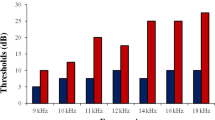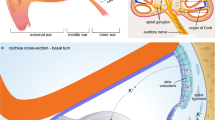Abstract
Introduction
The sex hormones; estrogen and progesterone have a direct effect on the mechanisms of the inner cochlea and they control the functions of the ascending auditory pathway from the auditory nerve to the cerebral cortex. Therefore, the aim of this study was to determine the amplitude of distortion product of otoacoustic emissions (DPOAE) in postmenopausal women.
Materials and Methods
This cross-sectional case-control study included 60 women who were naturally menopausal and were in the age range of 55 − 45 years (case group). The other 60 included women of the same age and non-menopause (control group). Both groups were selected from individuals who had normal auditory function based on pure tone audiometry, immitance audiometry (tympanometry + ipsilateral and contralateral reflex), speech tests and auditory brainstem responses. Then both groups were evaluated by DPOAE and its findings were analyzed in two groups based on independent t-test and the significance level of the test was determined to be less than 0.05.
Results
The difference between the mean DPOAE domains in the two groups was not significant (P-value = 0.484).
Conclusion
Menopause is not an etiological factor to be created of abnormalities in the cochlea of the inner ear.
Similar content being viewed by others
References
Rhodes ME, Rubin RT (1999) Functional sex differences (“sexual diergism”) of central nervous system cholinergic systems, vasopressin, and hypothalamic-pituitary-adrenal axis activity inmammals: A selective review. Brain Res Brain Res Rev 30(2):135–152
Lombardi G, Zarrilli S, Colao A, Paesano L, Di Somma C, Rossi F et al (2001) Estrogens and health in males. Mol Cell Endocrinol 178(1–2):51–55
Lee JH, Marcus DC (2001) Estrogen acutely inhibits ion transport by isolated stria vascularis. Hear Res 158(1–2):123–130
Wharton JA, Church GT (2009) Influence of Menopause on the Auditory Brainstem Response. Audiology. Published online
Hederstierna C, Hultcrantz M, Collins A, Rosenhall U (2007) Hearing in women at menopause. Prevalence of hearing loss, audiometric configuration and relation to hormone replacement therapy. Acta Otolaryngol 127(2):149–155
Djahanbakhch O, Swanton IA, Corrie JE, McNeilly AS (1981) Prediction of ovulation by progesterone. Lancet 2(8256):1164–1165
Mauri A, Martellotta MC, Melis MR, Caminiti F, Serri F, Fratta W (1990) Plasma alpha-melanocyte-stimulating hormone during the menstrual cycle in women. Horm Res 34(2):66–70
Kirschbaum C, Kudielka BM, Gaab J, Schommer NC, Hellhammer DH (1999) Impact of gender, menstrual cycle phase, and oral contraceptives on the activity of the hypothalamus-pituitary-adrenal axis. Psychosom Med 61(2):154–162
Kostoglou-Athanassiou I, Treacher DF, Wheeler MJ, Forsling ML (1998) Melatonin administration and pituitary hormone secretion. Clin Endocrinol (Oxf) 48(1):31–37
Forsling ML, Anderson CH, Wheeler MJ, Raju KS (1996) The effect of oophorectomy and hormone replacement on neurohypophyseal hormone secretion in women. Clin Endocrinol (Oxf) 44(1):39–44
Tollan A, Oian P, Fadnes HO, Maltau JM (1993) Evidence for altered transcapillary fluid balance in women with the premenstrual syndrome. Acta Obstet Gynecol Scand 72(4):238–242
Genazzani AR, Stomati M, Morittu A, Bernardi F, Monteleone P, Casarosa E et al (2000) Progesterone, progestagens and the central nervous system. Hum Reprod 15(Suppl 1):14–27
Pfaff DW, Vasudevan N, Attardi B (2000) Neuroendocrine regulation of sexual behavior. In: Conn PM, Freeman ME (eds) Neuroendocrinology in physiology and medicine. Humana Press Inc, Totowa, NJ, pp 287–299
Stuart A, Yang EY (2001) Gender effects in auditory brainstem responses to air- and bone-conducted clicks in neonates. J Commun Disord 34(3):229–239. https://doi.org/10.1016/s0021-9924(01)00048-x
de Courten-Myers GM (1999) The human cerebral cortex: Gender differences in structure and function. J Neuropathol Exp Neurol 58(3):217–226. https://doi.org/10.1016/s0021-9924(01)00048-x
Lombardi G, Zarrilli S, Colao A, Paesano L, Di Somma C, Rossi F et al (2001) Estrogens and health in males. Mol Cell Endocrinol 178(1–2):51–55. https://doi.org/10.1016/s0303-7207(01)00420-8
Kim SH, Kang BM, Chae HD, Kim CH (2002) The association between serum estradiol level and hearing sensitivity in postmenopausal women. Obstet Gynecol. 99(5 Pt 1):726–730. https://doi.org/10.1016/s0029-7844(02)01963-4
Pearson JD, Morrell CH, Gordon-Salant S, Brant LJ, Metter EJ, Klein LL et al (1995) Gender differences in a longitudinal study of age-associated hearing loss. J Acoust Soc Am 97(2):1196–1205. https://doi.org/10.1121/1.412231
Guimaraes P, Zhu X, Cannon T, Kim S, Frisina RD (2004) Sex differences in distortion product otoacoustic emissions as a function of age in CBA mice. Hear Res 192(1–2):83–89. https://doi.org/10.1016/j.heares.2004.01.013
Sato H, Sando I, Takahashi H (1991) Sexual dimorphism and development of the human cochlea. Computer 3-d measurement. Acta Otolaryngol 111(6):1037–1040
McFadden D (1998) Sex differences in the auditory system. Dev Neuropsychol 14(2/3):261–298
Johansson MS, Arlinger SD (2002) Hearing threshold levels for an otologically unscreened, non-occupationally noise-exposed population in Sweden. Int J Audiol 41(3):180–194
Haapaniemi JJ (1996) The hearing threshold levels of children at school age. Ear Hear 17(6):469–477
Hall JW (2000) Distortion product and transient evoked OAEs: Nonpathologic factors influencing measurement. Handbook of otoacoustic emissions (Hall JW III. Singular Publishing Group, San Diego, pp 163–220
O’Rourke C, Driscoll C, Kei J, Smyth V (2002) A normative study of distortion-product otoacoustic emissions in 6-year-old schoolchildren. Int J Audiol 41(3):162–169
McFadden D (2000) Masculinizing effects on otoacoustic emissions and auditory evoked potentials in women using oral contraceptives. Hear Res 142(1–2):23–33
Dehan CP, Jerger J (1990) Analysis of gender differences in the auditory brainstem response. Laryngoscope 100(1):18–24
Stuart A, Yang EY (2001) Gender effects in auditory brainstem responses to air- and bone-conducted clicks in neonates. J Commun.
Hall JW III (1992) Effect of nonpathological subject characteristics. In:Handbook of auditory evoked responses (Hall JW III, ed), Boston: Allyn and Bacon. 163–220
Disord A, Yang EY (2001) Gender effects in auditory brainstem responses to air- and bone-conducted clicks in neonates. J Commun Disord. 34(3):229–239
Kilicdag EB, Yavuz H, Bagis T, Tarim E, Erkan AN, Kazanci F (2004) Effects of estrogen therapy on hearing in postmenopausal women. Am J Obstet Gynecol 190(1):77–82. https://doi.org/10.1016/j.ajog.2003.06.001
Guimaraes P, Frisina ST, Mapes F, Tadros SF, Frisina DR, Frisina RD (2006) Progestin negatively affects hearing in aged women. Proc Natl Acad SciUSA 103(38):14246–14249. https://doi.org/10.1073/pnas.0606891103
Bell A (1992) Circadian and menstrual rhythms in frequency variations of spontaneous otoacoustic emissions from human ears. Hear Res 58(1):91–100. https://doi.org/10.1016/0378-5955(92)90012-c
Haggerty HS, Lusted HS, Morton SC (1993) Statistical quantification of 24-h and monthly variabilities of spontaneous otoacoustic emission frequency in humans. Hear Res 70(1):31–49. https://doi.org/10.1016/0378-5955(93)90050-b
Penner MJ, Zhang T (1997) Prevalence of spontaneous otoacoustic emissions in adults revisited. Hear Res. 103(1–2):28–34. https://doi.org/10.1016/s0378-5955(96)00162-1
Caruso S, Maiolino L, Agnello C, Garozzo A, Di Mari L, Serra A (2003) Effects of patch or gel estrogen therapies on auditory brainstem response in surgically postmenopausal women: A prospective, randomized study. Fertil Steril 79(3):556–561. https://doi.org/10.1016/s0015-0282(02)04763-5
Yellin MW, Stillman RD (1999) Otoacoustic emissions in normal-cycling females. J Am Acad Audiol 10(7):400–408 PMID: 10949944
Emami SE, Gohari N, Ramezani H, Borzouei M (2018) Hearing performance in the follicular-luteal phase of the menstrural cycle. Int J Otolaryngol. https://doi.org/10.1155/2018/7276359
Amit G, Animesh B (2004) Effect of hormones on TEOAEs. Indian J. Otol. 10(1):24–26. PMID: 10949944
Acknowledgements
This article is taken from the research project approved by Hamadan University of Medical Sciences with the project number 9710256412 and the authors know to thank and appreciate the material and spiritual support of the Vice Chancellor for Research and Technology and the esteemed patients who cooperated in this research.
Author information
Authors and Affiliations
Corresponding author
Ethics declarations
Compliance with ethical guidelines
All ethical principles were considered in this paper. The patients were informed of the purpose of the research. This study was approved by the Ethics Committee in research of Hamadan University of Medical Sciences with IR.REC.UMSHA.1397.514. Authors’ contributions were as follows;Methodology, data collection, data analysis, writing the original draft and article: corresponding author, editing: co-authors. This article has not been of any interest to the authors.
Additional information
Publisher’s Note
Springer Nature remains neutral with regard to jurisdictional claims in published maps and institutional affiliations.
Electronic Supplementary Material
Below is the link to the electronic supplementary material.
Rights and permissions
Springer Nature or its licensor holds exclusive rights to this article under a publishing agreement with the author(s) or other rightsholder(s); author self-archiving of the accepted manuscript version of this article is solely governed by the terms of such publishing agreement and applicable law.
About this article
Cite this article
Emami, S.F., farahani, F. & mortazavi, S. Studying of Distortion Product of Otoacoustic Emissions in Menopausal Women. Indian J Otolaryngol Head Neck Surg 75 (Suppl 1), 88–92 (2023). https://doi.org/10.1007/s12070-022-03210-1
Received:
Accepted:
Published:
Issue Date:
DOI: https://doi.org/10.1007/s12070-022-03210-1




